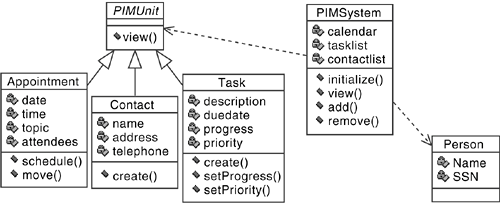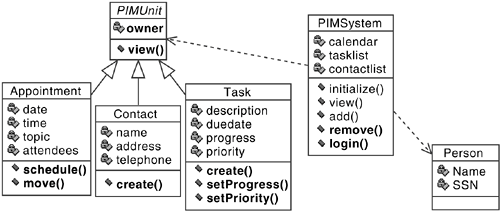Section 27.3. AN EXPERIENCE REPORT
27.3. AN EXPERIENCE REPORTThe goal of this section is to describe how AOP can be used to implement application security. We describe two case studies of security aspects. The first is a didactical example that illustrates the approach; the second applies that approach to a real-life application, a server for file transfer. We conclude with a discussion that generalizes these ideas in a reusable security aspect framework. 27.3.1. A Personal Information Management SystemOur first example describes a Personal Information Management (PIM) system. A PIM system backs up the human memory by keeping track of personal information, including a person's agenda, contact information of friends and business contacts, the tasks he has to fulfill, and so forth. A Palm Pilot is a PIM. In this case study, we focus on the important requirement of access control. Figure 27-1 shows the class diagram of a simplified PIM system. PIMSystem is the heart of the model. Through this class, the system can represent and manage three different types of information (or PIMUnits): appointments, contacts, and tasks. Besides a common operation represented in the abstract PIMUnit class, each information type requires different fields and operations. Finally, different Persons may perform operations on the system. Implementing access control in this system requires defining both the access control model and the mechanism for enforcing it. In our example, the owner-based access control model has the following rules:
Figure 27-1. PIM system class diagram.
These rules are not complex. However, an object-oriented implementation of this access control model into the PIM context is not straightforward. First, every PIMUnit must be associated with its owner. This can be achieved by inserting an owner attribute into the PIMUnit class, initialized when the unit is created. Then, since access control requires that the real identity of the person responsible for initiating an operation is known, an authentication mechanism must be added to the model. We chose to do this in the general PIMSystem class. Finally, for the actual authorization checks, most operations in the four unit classes must be modified: The signature of the operations must be altered to pass identity information from PIMSystem to the authorization checks. As a result, the initial model has to be changed into a model, as shown in Figure 27-2, where the items in bold represent the places that require changes (both structural and behavioral). Crosscutting is epidemic. Figure 27-2. PIM system modifications for access control.
Listing 27-1 shows the implementation of the same access control functionality using AspectJ. The first aspect, Ownermanagement, is responsible for storage and initialization of the PIM unit owners. To this end, an instance of the aspect is associated (created) with every PIMUnit object. Every unit will be decorated with an owner attribute that is initialized by the after advice when the unit is created. The Authentication aspect is used to authenticate persons and replaces the login() method that was introduced in the object-oriented implementation of access control. An attribute is included in this aspect that represents the current user, and an operation initializes this attribute.[2] Finally, the Authorization aspect implements the actual access control. Here, an around advice verifies the equality of the owner of the unit that is currently being accessed and the current user as identified through authentication and acts accordingly. In this aspect, the restrictedAccess pointcut specifies the places for enforcing this verification.
The aspect approach as proposed previously could be considered equivalent to a regular object-oriented implementation, but at first sight it might seem more complex and thus less attractive. However, the integral modularization as described here has a number of essential advantages. First, coping with changes, especially unanticipated ones, is easier because all relevant code is gathered into one place. Second, the proper modularization simplifies scaling when the size of the application increases. This example is not extensive enough to demonstrate this, but for real-life systems, the difference will be considerable. Third, because of the proper modularization, developers can concentrate on the real core of the problem without having to worry about side issues such as code consistency. Finally, the complete separation of concerns improves the understanding of which security measures are implemented and where and when they are activated. These advantages will be clarified in the following paragraphs. Listing 27-1. Access control aspect implementation aspect OwnerManagement perthis(this(PIMUnit)){ String owner ; //one per PIMUnit object after(): execution(Appointment.schedule(..)) || execution(Contact.create(..)) || execution(Task.create(..)){ owner = Authentication.getUser() ; } } aspect Authentication(){ static String currentUser ; //one per system static String getUser(){ if(currentUser == null) currentUser = <login> ; return currentUser ; } } aspect Authorization(){ pointcut restrictedAccess(): execution(* Appointment.move(..)) || execution(* Contact.view(..)) || execution(* Task.setProgress(..)) || execution(* Task.setPriority(..)) ; void around() : restrictedAccess(){ Object currentUnit = thisJoinPoint.getThis() ; String unitOwner = OwnerManagement.aspectOf(currentUnit).owner; String user = Authentication.getUser() ; if(! unitOwner.equals(user)) System.out.println("Access Denied !") ; else proceed() ; } } Consider a possible evolution of the PIM system. Suppose it is used by a company where different participating roles are defined, such as secretaries, managers, and so forth. The original design needs to be changed to reflect the different roles (which can be done by subclassing Person with several classes). In such an environment, the access control subsystem might also require an update. For example, secretaries may require full access to all information of their managers. This new requirement affects all access control checks. In the object-oriented security solution, these operations are dispersed among several classes (PIMUnit, Appointment, Task, and Contact). This extension requires considerable effort by the software maintainer, along with the possibility of introducing maintenance mistakes. For our aspect implementation, however, the only required change is the modification of the condition of the "if-statement" within the Authorization advice so that it includes this new access rule. The changes required to support this extension are more localized. This example of changing the access control model clearly demonstrates the flexibility gained by the advanced modularization capabilities of aspect-oriented programming. Similarly, other models can be supported equally elegantly. For instance, an ACL (Access Control List) based model would allow the owner to define fine-grained rules for the access rights of each person. In addition, different information confidentiality levels (such as public, confidential, and top-secret) could extend the access control model in order to further restrict information access in the system based on the user's clearance level. The AOP approach can even support a capability-based model, where one can delegate access privileges to others. All these models can be supported without requiring invasive changes in the core application software or unwarranted changes in the aspect implementation. 27.3.2. An FTP ServerOur second case study deals with the security requirements of jFTPd [17], a server that (partially) implements the well-known File Transfer Protocol (FTP). The implementation includes several security measures, most of which are imposed by the specification of the protocol. This case study only discusses access control, which is user-based. Users authenticate with a (user name and) password, once per connection, and then the current connection is linked with this user. FTP commands are executed only after proper authorization. In the implementation of the FTP, FTPHandler is the central class in the model that takes care of incoming connection setup requests. For every request, FTPHandler instantiates an FTPConnection object and assigns the incoming connection to it. From this point onwards, the latter acts as the primary contact point for the connection, which means that it is responsible for reading and answering all incoming FTP requests on the connection. It has a central input operation that delegates each command input to an appropriate suboperation depending on the specific request. At the end of an FTP session, the connection is closed, and the connection object is destroyed. A user-based access control model can be successfully implemented using AOP technology. We briefly sketch the aspect structure and strategy used.[3] FTP security is session-orientedthe credentials presented at login are used throughout the entire session. Therefore, similar to the OwnerManagement aspect of the previous example, an FTPSession aspect is associated with the FTPConnection class and holds the information from the authentication phase. Furthermore, a second aspect, FTPConnectionSecurity, performs two important tasks: In the authentication phase, it checks username/password combinations (and fills in the outcome in the FTPSession aspect), and in the various FTP commands of the FTPConnection class, it performs the actual access control. Finally, the aspect implementation includes two other aspects for dealing with the representation and initialization of some other security parameters that are not relevant to this discussion. Through the aspect implementation, a complete separation of security-related code is achieved from the initial implementation of the FTP server. In other words, we are able to deploy the FTP server with or without weaving in (i.e., bind and activate) the security aspects.
27.3.3. Toward a Framework of AspectsThe deployment of the aspects described in the previous examples depends heavily on the type and implementation of the actual application. For instance, the Authorization aspect of Section 27.1 can only be used for PIMUnit classes, not for FTPConnections. Also, the explicit choice to have system-wide personal authentication in the first case study limits the applicability of that specific aspect. In general, it seems hard to define a single set of aspects that is applicable in a broad range of applications. However, just as Java classes can be made abstract to represent generic behavior, one would like the ability to implement generic aspects that can be reused in several cases. A closer look at the previous aspects reveals two obstacles that hinder their reuse.
The key to resolving the first problem is identifying the generic domain concepts and their mutual dependencies while ignoring the particular implementation details of the underlying application. In the two case studies, three common concepts can be identified: (1) an authentication concept that stores information about the subject initiating an access attempt and that guarantees the correct identity of the subject, (2) a resource concept that models resource-specific information required for access control, and (3) an authorization concept that implements the access controls for every attempt to access the resource, possibly based on subject and resource information. In the first case study, the three aspects map nicely onto the previous concepts (notice that OwnerManagement implements the resource concept). In the second case study, both discussed aspects (FTPSession and FTPConnectionSecurity) actually represent distinct parts of the authentication concept and hence should be merged. The authorization concept maps directly; the resource concept has not been used. In short, it is fair to state that the technology does not stop us from generating reusable results. To address the second problem, AspectJ supports abstract definitions of pointcuts. Specific pointcuts can be instantiated afterwards in an extended aspect. Using this mechanism, it is possible to build a general aspect and redefine the abstract pointcuts based on a specific application. Combining the two solutions discussed here results in aspect code as shown in Listing 27-2. While the intellectual effort of this generalization phase is nontrivial, it allows the reuse of the core structure of the security aspects. A qualified person properly designs security solutions once. Later, aspect inheritance enables reuse. Furthermore, by continuing this exercise for other security requirements (such as confidentiality, non-repudiation, etc.), a combination of security aspects can be built that form the basis of an aspect framework for security. This framework consists of core structures modeling security requirements, concrete mechanism implementations for these requirements, and abstract pointcuts that must be extended for specific applications. In Listing 27-2, the concrete mechanisms still require an implementation at the places represented by "<. . .>". A more elaborate discussion on this security framework can be found in [31]. Listing 27-2. Generalized aspects for access control abstract aspect Authentication perthis(entities){ abstract pointcut entities() ; abstract pointcut authenticationPlace() ; private String id ; after(): authenticationPlace(){ id = <authenticate user> ; } } abstract aspect ResourceInformation perthis(resources) { abstract pointcut resources ; ... } abstract aspect Authorization{ abstract pointcut serviceRequest() ; void around(): serviceRequest(){ <check access> } } |
EAN: 2147483647
Pages: 307

